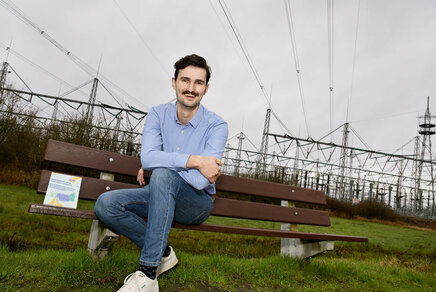Extending the range of battery electric vehicles using better models and cell balancing
Feye Hoekstra defended his PhD thesis at the department of Electrical Engineering on October 7th.

The transportation sector is one of the largest consumers of fossil fuels, and, as a result, emitter of greenhouse gases. Cleaner alternatives based on wind and solar to power the sector are needed, in addition to high-capacity batteries that are also light. Right now, electrochemical batteries are best suited for this, in particular lithium-ion batteries. Besides designing better batteries for vehicles, the focus should also be on extending the practical range of Battery Electric Vehicles. For his PhD research, Feye Hoekstra looked at three aspects of developing batteries vehicles: increasing battery model accuracy, improving state estimation and active cell balancing.
In Battery Electric Vehicles (BEVs), lithium-ion is the material of choice for most batteries due to its high-energy density storage capability. While batteries improve with technical advancements, it’s important to not only look at making better batteries, but also on how to use these batteries as efficiently as possible, and increase the range of the batteries as much as possible. The main challenge is to ensure that all batteries remain within certain safe limits in terms of current, voltage, and temperature. Otherwise, batteries can deteriorate rapidly or even explode.
Two problems with range
The safe limits that are in place are important, but they impede the range of the BEVs. First, the amount of energy that can be discharged, which is used to propel the BEV and thus determines its range, without violating any of these limits needs to be predicted. Models are used for these estimations, but no model is perfect. Added to that, it’s difficult to say what exactly is happening in the battery during use. As a result, conservative, more careful predictions of the range are used. By playing it safe, the distance range of the vehicle is smaller.
The second problem is that all battery cells in the battery pack are different. This effect is limited for new batteries, but can strongly increase over time as some cells in the batteries age more rapidly than others. Due to the interconnection structure of the battery cells in the pack, the performance of the pack is determined by the weakest cell. Consequently, some energy in stronger cells remains unused. This problem also contributes to a much lower distance range for BEV in practice than is predicted by theory.

Three aspects
For his PhD research, Feye Hoekstra looked at three aspects of these two problems: increasing battery model accuracy, improving state estimation, and active cell balancing.
First, better models allow for more accurate predictions of the battery behavior during use. Moreover, it’s possible to better figure out what is happening inside the batteries by comparing measurements and model predictions.
Second, this helps with a better state estimation of the current status of specific parts of the battery, which cannot be measured or should not be measured due to additional costs. This is an existing approach, but by increasing the accuracy of the prediction models, predictions can still apply for longer periods of time, and leads to a reduction in complex computations. Overall, this makes this approach more accessible and less expensive for large battery packs.
Third, active balancing, which is the transportation of energy from one cell to another, can mitigate the negative influence of weak cells in the battery pack by supporting them with energy from stronger cells, such that the BEV powered by the battery pack has a larger range. Hoekstra showed that this can extend the effective lifespan of a battery pack by about 10%.
In conclusion, the contributions in Hoekstra’s research allow for more efficient modelling, facilitates accurate and efficient state estimation, and allows for more effective use of the available energy in a battery pack through active cell balancing. Combined, this increases the overall range of a BEV, lowers the initial cost, and extends the effective lifespan.
Title of PhD thesis: Battery electric vehicle range extension by empirical battery modelling, state estimation, and active cell balancing. Supervisors: Tijs Donkers and Henk Jan Bergveld.
More on Sustainability



Latest news


